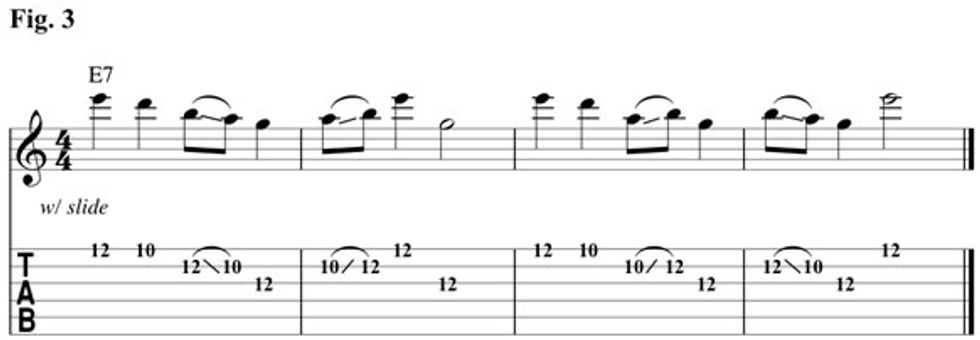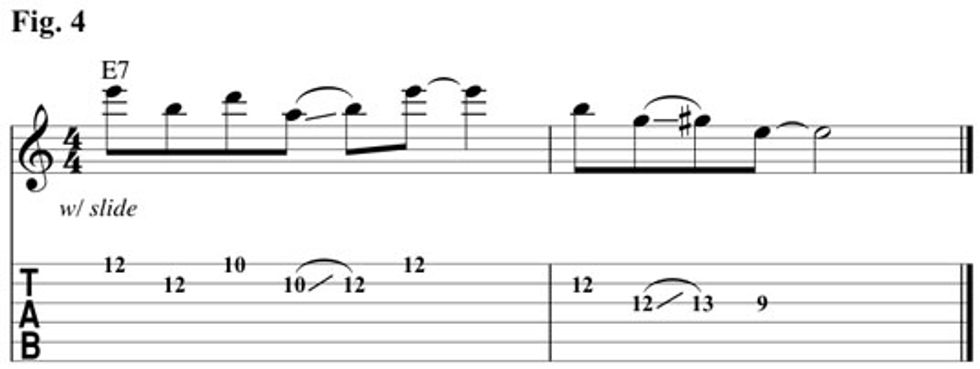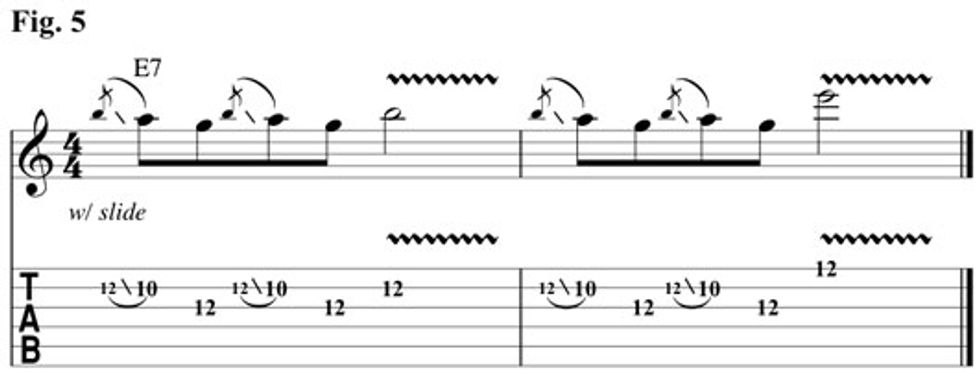The sound of slide guitar is incredibly intoxicating. I’ve always been drawn to it because of the singing, vocal quality that it has—so emotional and expressive.
Chops: Intermediate
Theory: Beginner
Lesson Overview:
• Understand the advantages
of playing slide guitar in standard
tuning.
• Develop picking-hand muting
and accurate intonation.
• Create phrases in the style
of Duane Allman and Derek
Trucks.
The sound of slide guitar is incredibly intoxicating. I’ve always been drawn to it because of the singing, vocal quality that it has—so emotional and expressive. It’s very prominent in blues and roots rock, but as an approach and set of techniques, I think slide guitar is truly useful in all styles.
The conventional wisdom for slide playing is to use an open tuning, where you retune your guitar so that strumming the open strings creates a chord. Two popular slide tunings are open E (E–B–E–G#–B–E, low to high) and open G (D–G–D–G– B–D, low to high). The most compelling benefit to this approach is that anywhere you put the slide you’ll have a nice big chord. This is also a fundamental compromise with two serious drawbacks. First, you are now bound to only major chords, and even worse, all the notes and their positions that you have already worked so hard to learn are gone because you’ve retuned half of the strings.
Luckily, this isn’t the only way to get your hands around some greasy slide licks. Using standard tuning is just as viable and some of the greatest slide guitarists in the world use it. What’s great about learning slide techniques in standard tuning is that you can apply them to any tuning you want down the road too. The techniques are difficult enough as it is, so let’s get rockin’ with the tuning you’re already used to.
The biggest adjustment for most players is the sense of touch and how lightly you have to actually rest on the strings with the slide. Typically, players will use thick strings and high action. I use stock action and .010–.046 light strings. There are some folks who take it to the extreme. Billy Gibbons plays a super-light .008 set, even when playing slide. Talk about a light touch. A-how-how-how!
A great first way to recalibrate your sense of touch for slide playing is to test the action. Without the slide, press the strings to the fretboard and then release—without leaving the strings—several times to feel the “springiness” of the strings. You’ll notice that the action, or distance from the string to the fretboard, is very close. This does not give you a lot of room, so it’s really important to be sensitive to that tiny distance.
Next, play a harmonic on the 1st string by gently touching directly above the 12th fret. Notice that you have to be very gentle and you can’t press through to the fretboard. This is how lightly you have to touch the string with the slide. Let the slide float on top of the strings and be supported by the strings. Also, make sure you are touching the string with the slide directly above the metal fret.
Another very important tip: Use your fingertips to pluck the strings instead of a pick, so that you can use all of your other fingertips to mute unwanted noise. Keep these things in mind when you grab your slide and you’ll be tearing it up in no time.
Let’s begin with a simple muting exercise shown using the E minor pentatonic scale in Fig. 1. The goal here is to separate each note by muting the adjacent strings with your plucking-hand fingers. Make sure to land directly over the fret and test your intonation with a tuner. Remember, no sliding! It should sound like you are playing through the scale with fretted notes.

In Fig. 2 we start to connect some of the notes in the scale. Muting is especially important here, as you don’t want any of the other strings to ring and create some weird overtones. Keep the sound of each note even and in time even though some of the slides are longer than others. On the last note try using some vibrato.

To create an even-sounding vibrato you want to try to move the slide an equal distance on either side of the target pitch. Don’t worry if it isn’t completely perfect— vibrato is unique to each player and it helps to define your personal sound.
Now that the exercises are out of the way, we can move onto some actual licks in Fig. 3. As you can see, we combine elements of both Fig. 1 and Fig. 2 to create a simple phrase over E7. For the second part of the phrase, place your thumb on the 3rd string, index on the 2nd string, and middle on the 1st string. This will allow you to mute the proper strings much more easily.

We have a “see-saw” lick in Fig. 4 using the same pentatonic box. We dip outside the pentatonic scale for the G# in the second measure. This note is the major 3rd of the E7 chord and gives the phrase a nice, sweet quality. Create some separation between the G# and the E by muting the 3rd string with your thumb.

In Fig. 5 we have a Duane Allman inspired lick that makes use of some grace notes. A grace note is when you quickly sound a note right before your target note. With this example, the B is the grace note and the A is the target note. These types of phrases really show how you can get a vocal quality with the slide. Just to prove it, try playing the lick without the slide and see how different it sounds. Slide on!

 Geoff Hartwell is a NYC-based guitarist, singer,
songwriter, and instructor. His forthcoming
album features Kofi Burbridge and Yonrico
Scott from the Derek Trucks Band, and Oteil
Burbridge of the Allman Brothers. For more
information and to check out his instructional
DVD, Ultimate Slide Guitar: Essential Slide
Techniques, visit geoffhartwell.com.
Geoff Hartwell is a NYC-based guitarist, singer,
songwriter, and instructor. His forthcoming
album features Kofi Burbridge and Yonrico
Scott from the Derek Trucks Band, and Oteil
Burbridge of the Allman Brothers. For more
information and to check out his instructional
DVD, Ultimate Slide Guitar: Essential Slide
Techniques, visit geoffhartwell.com.
